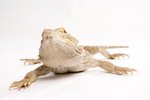
Many lizard enthusiasts want a pet that will tolerate interaction without displaying antagonistic behaviors such as biting. While several lizard species are typically docile and not inclined to bite, they all have mouths -- it is impossible to guarantee that a given individual will not bite the hands that feed him. Nevertheless, you usually can handle leopard geckos, crested geckos, bearded dragons and blue tongue skinks, without worry of being bitten.
Leopard Geckos
Leopard geckos (Eublepharis macularius) are usually very tame lizards who are amenable to brief handling sessions. It is important to avoid restraining your pet, which he likely will interpret as a threat and react by squirming, dropping his tail or biting. The best way to handle leopard geckos is to place your flattened hand in front of them, palm up. Gently coaxed into your hand, leopard geckos generally will begin walking around slowly and licking your hand. As is the case for most lizards, the juveniles are considerably more nervous than the adults, and are more likely to run or jump when held.
Crested Geckos
Crested geckos (Correlophus ciliatus) generally are not inclined to bite; however, handling them is not as easy as it is with terrestrial species, such as leopard geckos. Rather than bite, a frightened crested gecko is likely to scamper away or even jump. Because of this, it is important to hold them over a table or while seated on the floor -- that way, they won’t fall very far and hurt themselves. Crested geckos will autotomize their tails very readily, so be sure not to touch their tail while handling them.
Bearded Dragons
Bearded dragons (Pogona vitticeps) are revered as one of the most docile lizard species, and for the vast majority of individuals, their reputation is well deserved. Bearded dragons usually will tolerate more interaction with their keeper than most other commonly kept species. Interestingly, many bearded dragons are very calm indoors, but react aggressively toward their keepers when taken outside into natural sunlight. During those rare occasions when bearded dragons want to be left alone, they will express displeasure by displaying their beards and gaping their mouths. If these warnings are not headed, they will readily bite; however, these moods are infrequent, and easily avoided by leaving them alone when they signal displeasure.
Blue-Tongued Skinks
Blue-tongued skinks (Tiliqua ssp.) often make very calm, inoffensive pets. Usually displaying few signs of stress when handled, blue-tongued skinks are unlikely to bite defensively. Sometimes, stressed individuals will snort or breathe loudly when they are not in the mood for handling. Because they are opportunistic omnivores that readily consume mice and other large prey, exercise care to ensure that they do not mistake your fingers for food. Don't handle them during or after feeding time.
References
Resources
Photo Credits
-
Creatas/Creatas/Getty Images



